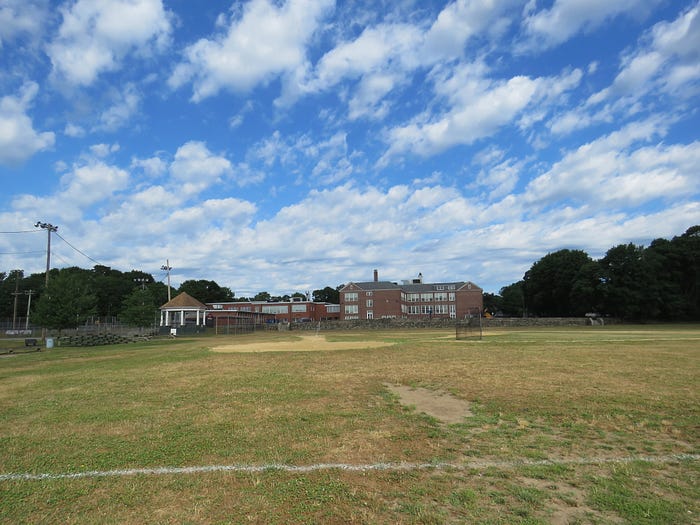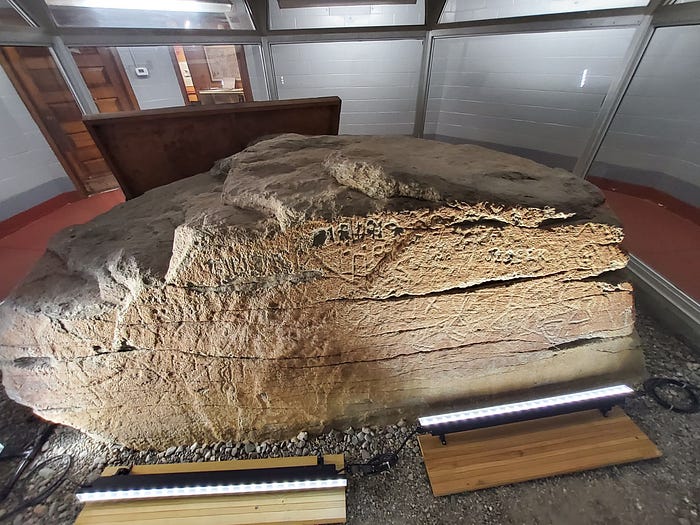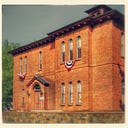Loves Me Like a Rock: Eight Old Colony Hunks You Should Know
Eric B. Schultz

“Remember the Maine, Plymouth Rock and the Golden Rule!”
–”Ya Got Trouble” from The Music Man
There’s something about rocks.
Search the web for “famous rocks” and you’ll discover everything from the Rosetta Stone to Ireland’s Blarney Stone. New England’s poet, Robert Frost, has written celebrated verses about “upper boulders” and “falling walls.”
Read some of the earliest land records from the Old Colony archives and you’ll find property lines beginning and ending at “the big pile of rocks near the old orchard.” The old orchard may now be the fourth hole of a golf course, but that pile of rocks is probably still sitting just off the fairway.
The Old Colony got its start on a rock, of course.
People last decades, buildings centuries, and ancient trees millennia. But rocks span eons. And for objects that never speak, they are filled with stories.
Here, we present eight rocks that help to tell the story of the Old Colony.
8. The Bobet Stone, Taunton

In the earliest days of King Philip’s War, Edward Bobet (Babbitt), his wife, and their nine children fled the nearly seven miles from their farm in present-day Berkley to the safety of the garrisons around Taunton Green. Shortly after, Edward and the family dog returned to their farm to secure some necessary domestic item. They were discovered and pursued by Natives, who Edward evaded by climbing and hiding in the branches of a tree. Unfortunately, so the story goes, his dog barked and gave him away.
Edward became Taunton’s first casualty of King Philip’s War. He was buried where he fell, a spot eventually marked by a crude headstone, now known as the Bobet Stone.
The Bobet Stone sat in a nearby stone wall for many years before it was moved, like the family before it, to the safekeeping of Taunton. Today, it is beautifully preserved and displayed in the Old Colony History Museum, part of the exhibit commemorating King Philip’s War.

In 1911, a bronze memorial tablet was set on the spot along Berkley Street where Bobet fell. Readers can visit this memorial — being respectful of the homeowners — found in the front yard of 696 Berkley Street.

7. Hand Rock, Middleborough
In June 1675, about the same time the Bobet family fled their farm, English settlers in Middleborough had gathered for protection in a garrison-fort not far from the town’s former middle school, on North Main Street. Their military leader was John Thompson (sometimes Thomson), who had brought for protection his long gun, a flintlock musket weighing 20 pounds and measuring more than seven feet.

About a half mile away across the Nemasket River, a small band of Wampanoag warriors had gathered near a rock on today’s Indian Hill. As the natives taunted the English, Thompson ordered Isaac Howland to fire a shot from the long gun in the direction of the warriors to serve notice that the English were not intimidated.
To everyone’s surprise, this legendary story concludes, one of the warriors standing on the rock fell mortally wounded, leaving a perfect imprint where his hand touched the stone.

Today, Hand Rock (on private property) is the best known of several Native hand petroglyphs (or rock carvings) found in the Middleborough area. While humans have been “pecking” hand carvings into rocks worldwide since Neanderthal times, the Old Colony is home to a cluster of remarkable examples.
Along with Hand Rock, researchers have discovered a pair of hand petroglyphs on a rock outcropping on Chestnut Street in Middleborough and perhaps as many as five on Great Rock, not far from the town’s center. Two rocks containing hand petroglyphs have been located on Assawompsett Lake at Betty’s Neck. In 1943, two hand petroglyphs were also found and photographed in Mattapoisett, though they can no longer be located.
Researchers speculate that these petroglyphs may have been marks of death or memorial, works of art, or property markers. “I have examined twelve hands in seven locations in southeastern New England,” Peter Anick of Brandeis wrote in 2019. “No two look completely alike.”
Visitors to the Old Colony History Museum in search of the Bobet Stone can also find the Thompson Long Gun prominently displayed. In the case across from the musket, a petroglyph thought to be from a “Praying Indian” graveyard in Dighton can be viewed.
6. Profile Rock, Freetown

While rocks may last forever, not so for rock formations. Water, sun, ice, gravity, and time can all take their toll. On Cannon Mountain in Franconia, New Hampshire, for example, the Old Man of the Mountain came crashing down in 2003. In Holliston, Massachusetts, the town’s iconic five-ton Balancing Rock, which survived efforts to topple it by George Washington and his staff, finally succumbed to gravity in 2020.
And so it was for Profile Rock, also called Massasoit Profile Rock and Old Man of Joshua’s Mountain. Located near the Freetown State Forest, this striking 50-foot granite outcropping cast a profile that reminded some of Wampanoag sachem Massasoit. Others knew that John Tisdale of Taunton had originally purchased the land and that his son, Joshua, settled and died there about 1714.

In 1955, the state of Massachusetts purchased 70 acres around Joshua’s Mountain. The Department of Natural Resources provided an access road, parking, and observation area. For decades, while law enforcement battled vandals determined to deface the profile, a steady stream of visitors came to pay their respects at this historic site.

On June 19, 2019, park officials discovered that a large portion of the rock formation had broken off and now lay in a heap. The surrounding area had become unstable. Like the Old Man of the Mountain before it, Profile Rock had succumbed to time and gravity.
5. Sachem Rock, East Bridgewater

Sachem Rock Farm on Plymouth Street, near the Satucket River in East Bridgewater, includes 31 acres first farmed three centuries ago. Located at the highest point on the farm, Sachem Rock is an outcropping of ledge that rises 25 feet and stretches over 70 feet and is best known as the site of one of the country’s earliest real estate deals.
On March 23, 1649, Myles Standish, Samuel Nash, and Constant Southworth met with Massasoit at this landmark to trade coats, hatchets, hoes, knives, moose skins, and cotton for land that extended seven miles in all four directions. This purchase would one day become Bridgewater, East Bridgewater, West Bridgewater, and Brockton.

Sachem Rock was near the site of a fording place and the intersection of two ancient native trails, a busy intersection that may have been the location of Pokanoket tribal councils. In 1956, the Old Bridgewater Tercentenary Committee erected a granite monument in honor of Massasoit. The following year, the Old Bridgewater Historical Society placed a memorial to commemorate this ancient land transaction.
Long a popular gathering place, in September 1998, East Bridgewater acquired the surrounding Sachem Rock Farm, a property added to the National Register of Historic Places in 2006. In the fall of 2012, the beautiful 5,000-square-foot Center at Sachem Rock was constructed.

Today, Sachem Rock is in a quiet wooded spot behind the Center, surrounded by hiking trails and East Bridgewater’s community garden.
4. Old Colony Stone Walls, “Everywhere”

While not a single rock, our choice of stone walls steals a page from Time magazine’s 2014 edition when its “Person of the Year” was “Ebola fighters.” Sometimes it takes a community to tell a story.
Residents can walk out their doors in almost any direction in the Old Colony and trip over a stone wall. A 1939 estimate determined that New England had about 240,000 miles of stone walls, enough length to encircle the coastline of the United States, and enough mass to outweigh all other ancient monuments combined.
Most stone walls were built by necessity to clear fields for farming. These “linear landfills” might be thigh-high, each boulder carried only as far and placed as high as a single farmer could manage. However, a landowner wishing to sue his neighbor for livestock damages would likely require the addition of wood or wire to make the wall “sheep high, bull strong, and hog tight.” The hardest of these specifications to satisfy was “hog tight,” but a stone wall less than 4½ feet high and not perfectly plumb might also have sheep dancing on top of it.
Ancient treasures and often works of art, Old Colony stone walls are most fully appreciated, a keen observer noted, once we no longer have to build them.
3. Anawan Rock, Rehoboth

The first of the Colony’s “big three,” Anawan Rock is located on Winthrop Street (Route 44) in Rehoboth, about seven miles from the Old Colony History Museum. A parking area and path make the site easy to access.
In the summer of 1676, after the death of King Philip, colonial troops began relentlessly hunting down the remaining bands of natives hidden in the woods of Plymouth Colony. One of the most sought-after leaders was Anawan, an elderly but distinguished soldier who had served Massasoit and Philip. Anawan had led perhaps fifty of Philip’s people, primarily women and children, to a secure camp in present-day Rehoboth. The site was protected on three sides by the Squannakonk Swamp, while its northern boundary featured an imposing rock, making a surprise entry to the camp perilous.
On August 28, 1676, Captain Benjamin Church discovered Anawan, marched with his men to the swamp, lowered himself down the face of the rock, and surprised the Wampanoag leader and his people. Anawan’s capture ended King Philip’s War in southern New England.

There are many accounts of Benjamin Church’s exploits at Anawan Rock, including his own heroic description. Other versions, such as that of Civil War General Ebenezer Peirce, found the rock less imposing and the capture of a hungry band of women and children something less than courageous. Today, readers can replay the story for themselves by visiting this historic site — knowing that the greatest modern danger can be reduced with bug and tick spray.

2. Dighton Rock, Berkley

Dighton Rock is an 11-foot, 40 to 50-ton “glacial erratic,” dragged and deposited by a receding glacier on the eastern shore of the Taunton River in Berkley, once part of Dighton. Covered in petroglyphs, Dighton Rock may be American archaeology’s most frequently documented artifact. By 1971, some 600 books and articles had appeared, advancing as many as 35 theories as to the source of the inscriptions.
Subject to myth and sometimes fierce scholarly debate for more than three centuries, the markings have been attributed to Indigenous peoples, the Lost Tribes of Israel, Egyptians, Phoenicians, Norsemen, semi-literate pirates, and Portuguese explorers. The latter theory, first advanced in the early twentieth century, hypothesized that the inscriptions were a record of a visit to the rock by Portuguese explorer Miguel Corte-Real, whose ship disappeared off the Newfoundland coast in 1502.
From 1889 to 1955, the Old Colony Historical Society owned and managed Dighton Rock. Acquired by the state in 1955, the Massachusetts Department of Natural Resources plucked the rock from the river in 1964 and constructed a landfill under it. While the river’s tide and vandals could no longer deface the inscriptions, the dry rock turned red and threatened to crumble, prompting the Department to erect a building as a protective shelter and interpretive center.

The most straightforward explanation for the inscriptions on Dighton Rock favors the work of America’s Indigenous people. However, the many theories offered through the centuries reflect the pride and optimism of immigrant groups that believe their story is an integral part of the nation’s founding.
While the Dighton Rock Museum is open by appointment only, readers can draw their conclusions by joining the Old Colony History Museum on its “Virtual Visit,” recorded in April 2022 and found on the Museum’s YouTube channel.

- Plymouth Rock, Plymouth
The traditional site of the Pilgrim’s landing in 1620, Plymouth Rock is the most famous rock in the Old Colony and probably the most renowned rock in the country. Inscribed with the date 1620, this chunk of Dedham granite has been on the shore of Plymouth for some 20,000 years. Some geologists think glaciers might have dragged it from Cape Ann, Cohasset, or the St. Lawrence River. And before that, as part of a tectonic plate, Plymouth Rock may have started life millions of years ago near modern Europe and crossed the Atlantic — long before the Pilgrims.
“On Munday,” William Bradford wrote, “they sounded ye harbor and found it fit for shipping, and marched into ye land.” Bradford was the Pilgrims’ firsthand historian, in the harbor where it happened. Yet, he did not mention a rock.
More than 120 years later, 94-year-old Thomas Faunce (b. 1647), clerk of the Plymouth records and an elder of the church, announced that he had been told that the giant boulder on shore, the one about to be covered by a wharf, had been the landing spot of the First Comers. Faunce was 40 years old when John Alden died in 1687, so he would have known the story of the rock from the folks who might have stepped on it. Nonetheless, the story of Plymouth Rock is rooted in the word of an old man.
At ten tons and resembling a grey bean bag, Plymouth Rock is half as large today as when the Pilgrims first saw it. In 1774, it split in two, with one part left buried along the shoreline and the rest planted in the town square. Over the next century, both sections lost bits, pieces, and sometimes slabs to the elements and patriotic souvenir hunters. In 1880, the two boulders were reunited by mortar and subsequently protected by a portico.

Today, little bits of the Old Colony are scattered around the country. The National Museum of American History has two pieces of Plymouth Rock, a chip from 1911 (“broken from the Mother Rock by Mr. Lewis Bradford on Tues. December 28 1850 4 1/2 o’clock p.m.”) and a slab from 1985. There’s a piece about the size of a breadbox at Plymouth Church in Brooklyn Heights, New York. Some bits of the rock got turned into earrings and cuff links.

Heading west, there was once 50 pounds of Plymouth Rock in Aurora, Nevada, brought there by Bridgewater’s A.E. Sherman in 1864, but it has since gone missing. Further west, many publications report that a hunk of the rock ended up in Gatos, California. If you can’t find any original granite there, you can ease your disappointment at Erik’s Delicafé in Los Gatos, which serves a piled-high turkey breast sandwich called “The Plymouth Rock.”
Like Dighton Rock, Plymouth Rock can be as much a mirror as granite. For most of its history, the rock symbolized America’s best qualities, celebrated by statesmen and citizens. But in 1970 and 1995, Plymouth Rock was buried by Native American activists as a symbol of theft and oppression during their National Day of Mourning. “We didn’t land on Plymouth Rock,” Malcolm X once said. “The rock landed on us.”
Visitors to Plymouth Rock are often disappointed by its size. But once you know its rich and evolving story, readers will recognize that it continues to loom large over the Old Colony.
To Learn More:
Those interested in learning more about New England stone walls will want to purchase a copy of Robert M. Thorson’s excellent Stone By Stone: The Magnificent History in New England’s Stone Walls. Place it on the bookshelf next to your collection of Robert Frost’s poetry and you will finally understand why “something there is that doesn’t love a wall.” Readers interested in Anawan Rock, Hand Rock, the Thompson Gun, and the Bobet Stone can find more information (in a shameless plug) in Schultz and Tougias’s King Philip’s War: The History and Legacy of America’s Forgotten Conflict. Don’t miss seeing the long gun and Bobet Stone at the Old Colony History Museum.
Two excellent pieces on the Old Colony’s petroglyphs are Edward J. Lenik’s “The Human Hand in Northeastern Rock Art: Communicating with the Spirits,” found in the Bulletin of the Massachusetts Archaeological Society 77 (1), Spring 2016, and Peter Anick’s “Shamans, Sachems, or Selfies: The Carved Hands of Southeastern New England” found in American Indian Rock Art, Volume 45. Also, National Geographic has launched a study of Northeast petroglyphs that is mapped, illustrated, occasionally updated, and worth following.
The best piece ever written on Plymouth Rock is undoubtedly John McPhee’s “Travels of the Rock,” though nearly everything McPhee has written falls in the category of “best ever.” Finally, as mentioned above, for a recent, superb discussion of the many interpretations of Dighton Rock, don’t miss Douglas Hunter’s The Place of Stone: Dighton Rock and the Erasure of America’s Indigenous Past. Dighton Rock will also be featured in Katie MacDonald and William Hanna’s upcoming book, Tetiquet to the Sea: A History of the Taunton River.
